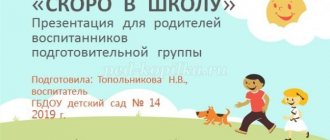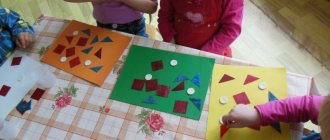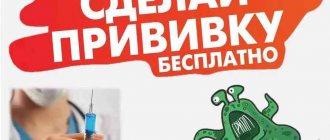Parent meeting in a mixed-age group “We want our children to become...” material
Parent meeting in a mixed age group
Goals: expanding contact between teachers and parents; modeling prospects for interaction for the new academic year; improving the pedagogical culture of parents.
Material: questionnaires, newspaper, booklets
Event plan
1. Introductory part. Congratulations to parents on the beginning of the school year.
Familiarization with the plan for holding parent meetings.
2. Familiarization of parents with the goals and objectives of the GBOU OOSH SP Kindergarten for the new school year. Features of the educational process and additional educational services in the senior group.
3. Joint discussion “Age characteristics of children 2-7 years old.”
4. Election of the composition of the parent committee.
5. Miscellaneous.
Progress of the event
- Introductory part.
At the entrance to the group, parents are asked to fill out the newspaper “We want our children to become...”.
Good evening, dear parents! We are very glad to see you in our group. Today we have our first parent meeting, where we will get to know each other better. We are very glad to see you at the parent meeting, because we understand: without an alliance with children, without your support and help, raising them and creating a cozy and joyful environment for them in kindergarten is an impossible task. And you and I have one common goal: to make their stay here comfortable, safe, interesting, exciting, educational, etc. We hope that you and I will live as one friendly family.
During a child’s stay in kindergarten, we form a triangle (children, teachers, parents). At the head of the triangle, of course, is the child. What do you think will happen to a tripod stool if one leg breaks? (will fall) That's right, he will fall! Remember Krylov’s fable “The Swan, the Crayfish and the Pike,” where it says: “When there is no agreement among the comrades, their business will not go well, the result will be nothing but torment!”
Educator: Look at our wonderful newspaper. What do parents expect from their children?
So that they become strong, smart, honest, healthy, inquisitive, etc.
We have known each other for a long time, but maybe you don’t all know each other?
I would like to remind you that our children have become a year older. We have a daily routine, time and number of classes per day. Features of the educational process in the group.
The daily routine for each age should be different. Since we have only one group, we work according to the senior group schedule so that older and younger children suffer less. (Shows daily routine and activity schedule)
Check out your daily routine.
Direct educational activities and additional educational services: rhythm, drawing. Additional educational services are provided by teacher Anna Alekseevna Provotorova 2 times a week.
Today we are working on the preschool education program “From Birth to School” edited by Veraksa N. E., Vasilyeva T. S., Komarova M. A.
For older children, their responsibilities increase. And we would really like you, the parents, to take the educational process seriously. I will introduce you to the goals and objectives of the joint venture for the new academic year.
2. Introducing parents to goals and objectives
Tasks for older children:
1. Develop and strengthen the physical health of preschool children through improving the education system and developing skills for leading a healthy lifestyle;
2. To increase the effectiveness of work on the development of speech and verbal communication of preschoolers through familiarization with works of fiction;
3. Creation of a comfortable subject-developmental and speech environment - as one of the main conditions for the full general and speech development of preschool children, mastering the communicative function of language.
4. To form the communicative competence of preschoolers through the development of children’s speech in the process of organizing various types of children’s activities in accordance with the Federal State Educational Standard.
Tasks for younger children:
1. Formation of components of the speech system of preschool children through the development of fine motor skills of the hands;
2. Development of social and communicative activities of pupils through the organization of various types and forms of gaming activities.
Educator: The rules of our group.
Tell me, can you make a clap with one palm? Need a second hand. The clap is the result of the action of two palms. A teacher is only one palm. And no matter how strong, creative and wise she is, without a second palm (and it is in your face, dear parents), the teacher is powerless. From this we can derive the first rule:
*Only together, all together, we will overcome all difficulties in raising children.
Take everything by flower and color them. Now compare your flower with the flowers of your neighbors. All the flowers were the same in shape and size. Tell me, after you have painted a flower, can you find two completely identical flowers? We, adults, under the same conditions, do everything differently. Hence our second rule:
*Never compare your child with another!
We will compare, but these will only be the results of the same child yesterday, today and tomorrow. This is called monitoring. We will do this in order to know how and what to do with it tomorrow. We will do this in order to grow every day. And not only in knowledge, but also in actions.
I would like to read the words of the famous teacher A.S. Makarenko “Our children are our old age. Proper upbringing is a happy old age, bad upbringing is our future grief, our tears, it’s our guilt before other people, before antiquity.”
3. Joint discussion “Age characteristics of children 2-7 years old.”
Young age is an important period in the development of a preschooler, which is characterized by high intensity of physical and mental development. At this time, the child transitions to new relationships with adults, peers, and the objective world.
Psychologists pay attention to the “three-year crisis,” when the youngest preschooler, who until recently was so easy-going, begins to show intolerance towards adult supervision, a desire to insist on his demands, and persistence in achieving his goals. This indicates that the previous type of relationship between an adult and a child should be changed in the direction of providing the preschooler with greater independence. If a new relationship with a child does not develop, his initiative is not encouraged, his independence is constantly limited, then whims, stubbornness, obstinacy arise (this does not happen in contact with peers)
Independence is a valuable quality that a person needs in life.
It is necessary to educate him from early childhood. By nature, children are active; very often they strive to perform various actions independently. And it is important for us, adults, to support them in this.
Often, each of us, in response to an offer to do something for a child or help him with something, had to hear “I myself!”
At this age, the child realizes himself as a separate person, with his own desires and characteristics. The child practically becomes independent: he can perform many actions without the help of an adult, and learns self-service skills.
What can they do independently at a younger age?
Wash your hands by rolling up your sleeves; wash your face without splashing water; use soap correctly; do not wet clothes; Dry yourself with a towel, hang it in the designated place without being reminded.
Dress and undress in a certain sequence: take off clothes, fold them, hang them, turn them right side out; put on clothes, unfasten buttons, fasten them, tie shoelaces.
Notice the mess in your clothes and fix it yourself or seek help from an adult.
Use a handkerchief and toilet in a timely manner.
Drink from a cup; eat, chewing food well, with your mouth closed.
Use a spoon, fork, and napkin correctly.
Place toys, books, and building materials in a specific place.
Of course, the child does not immediately acquire the necessary skills; he needs our help, creating the necessary conditions for the manifestation of independence, correctly guiding the actions of children and be sure to praise, praise for the slightest manifestation of independence.
"Age characteristics of older children."
Parents are the first teachers. They are obliged to lay the foundations for the physical, moral and intellectual development of the child’s personality in early childhood.”
The child must be able to take care of himself, undress and dress independently, and maintain order in his locker. It is very important to teach your child hygiene and to treat things with care. This is necessary so that in the future the child can quickly adapt to school; he must be quite independent. Try to patronize him less, give him the opportunity to make independent decisions and be responsible for them.
Entrust him with some household chores, he has learned to do his work without the help of adults. Older preschoolers can set the table, wash dishes, clean their clothes and shoes, look after younger children, feed fish, birds, a kitten, and water flowers. Parents should not do what their children forgot or did not want to do. Practice shows that if children, before entering school, had responsibilities at home that were feasible for them, they could more easily cope with educational activities.
4. Election of the composition of the parent committee.
Educator: Your desire to help us in raising and organizing an interesting life for children makes it possible to hope that no one will be left behind. The parent committee will help us a lot with this.
Selection of the parent committee
The work of the parent committee of the group is regulated by the document of the educational institution.”
Chairman of the parent committee: (he is a representative from the group,
Deputy Chairman of the Parents Committee (his right hand);
secretary of the parent meeting;
The Parent Committee is a group of parents responsible for implementing measures to strengthen the material, technical and visual-didactic base of the group, landscaping and creating normal sanitary and hygienic conditions in it;
(purchasing gifts for birthday people, organizing “sweet evenings”, etc.);
(carrying out and equipping activities aimed at strengthening and preserving the health of pupils);
(involving parents to participate in educational, cultural and mass work with students outside of developmental activities);
Educator: Offer your candidacies
Parental votes are counted, the results are announced, and the personal composition of the group’s parent committee is discussed. The parent committee is approved by direct vote.
At the end of our meeting I would like to say. In any team, understanding, good relationships, mutual assistance and mutual respect are very important. The conditions for normal relations between children and parents, children and teachers, teachers and parents are the ability to give in to each other and mutual tolerance. “Children are happiness created by our work!”
5. Miscellaneous
*If for some reason the child was not brought to the kindergarten, then inform the teacher or caretaker in advance, because she makes up the menu.
*After a child’s illness, inform about his departure to kindergarten the day before.
*If the child is absent from kindergarten due to family reasons, you must write a statement addressed to the director; if your children are taken by non-adult children, you must write statements in free form and that you take responsibility for the lives of the children.
Children must have a sports uniform
Not a single child is immune from physiological “trouble”; he can get dirty with paint, get his clothes wet with water, please bring spare clothes.
Don't forget that payment for kindergarten is due on the 20th.
I hope that parents will take note of our recommendations and try, by following these simple rules, to help teachers make life in kindergarten joyful, interesting, healthy and safe.
Summary of parent-teacher meetings in a mixed-age (middle and junior) group
Summary of the parent meeting in the multi-age (middle and junior) group of MKOU Secondary School No. 8
prepared and conducted by group teacher Kulakova O.P.
Topic: “The beginning of the school year is the beginning of a new stage in the life of the kindergarten and its students.”
Goals:
expanding contact between teachers and parents; modeling prospects for interaction for the new academic year; improving the pedagogical culture of parents. Tasks:
consider the age and individual characteristics of children 4-5 years old; introduce parents to the tasks and features of educational work, the tasks of the preschool institution for the new school year; update the personal data of the families of the pupils; teach parents to observe the child, study him, see successes and failures, try to help him develop at his own pace; intensify work on children's speech development.
Meeting plan: 1 Congratulations to parents on the start of the school year.
2 Familiarization with goals and objectives before
3 Consultation: Topic: “Age and individual characteristics of children 4-5 years old.”
4 Adaptation of children 5. Results of the meeting
Progress of the meeting:
Good evening, dear parents! We are very glad to see you in our cozy group!
The theme of our meeting is “The beginning of the school year - the beginning of a new stage in the life of the kindergarten and its students.” Briefly about what your children have to know and learn this year. We work according to the Program “From birth to school” edited by N, E, Veraksa, M, A, Vasilyeva, T, S, Komarova.
The goals of the Program: creating favorable conditions for a full-fledged life for a child in preschool childhood, forming the foundations of a basic personality culture, comprehensive development of mental and physical qualities in accordance with age and individual characteristics, preparing a child for life in modern society.
To achieve these goals, the following tasks have been identified:
- care for the health, emotional well-being and timely comprehensive development of each child.
-creating an atmosphere of friendly attitude towards each student in the group
-develop creativity in accordance with the interests and inclinations of each student and respect the results of children's creativity
-ensure the development of every child
-ensure family participation in the life of the group
Our goal with you is not only training but also education. Working together we can raise wonderful, responsive, friendly and well-rounded children.
The program was developed in accordance with the Law of the Russian Federation “On Education in the Russian Federation” dated December 29, 2012 No. 273-FZ, the Federal State Educational Standard for Preschool Education. The preschool implements FIVE DIRECTIONS OF PRESCHOOL EDUCATION FSES
Classes are held from Monday to Friday.
Social and communicative development
Moral education, play, joint activities with peers; communication with adults and peers, work, creativity, life safety
Cognitive development
Creativity, the world around us, mathematics, constructive research activities, music. We introduce children to the concepts of “People - comparison of people of different ages and genders, different emotional states, features of appearance, occupation of adults.”
Speech development
Teaching coherent speech, literacy, acquaintance with book culture, children's literature, enriching the vocabulary.
Artistic and aesthetic development
Productive activities: drawing, modeling, appliqué, design, manual labor, theatrical performance, music, verbal creativity and folklore.
Physical development
Outdoor and sports games, exercises, all possible types of gymnastics, basic movements, health care, hygiene, proper nutrition.
Every morning morning exercises are carried out at 8-15, please do not be late, because the child’s mood for the whole day depends on the exercises. Every second week, physical education and musical leisure activities are held. Also, individual work is carried out with children on mastering and consolidating certain educational skills regions
In our group, subject developmental education is organized so that every child can find something to their liking, can believe in their strengths and abilities, learn to interact with teachers and peers, understand and evaluate their feelings and actions, and this is the basis of developmental education .
You all know your children well, their habits and characteristics. For each of you, your child is unique and inimitable. But you’ve probably thought about the fact that not everyone understands his behavior, preferences and whims. Each child develops differently, each has its own path and pace of development. But there is still something in common that allows us to characterize children and their age characteristics. The age of 4-5 years is rightly called middle preschool. Closer to the age of five, children begin to display features characteristic of older preschoolers: some arbitrariness of mental processes, growth in cognitive interests and independence, attempts to explain the phenomena of life around them that interest them. Curiosity, the need for independence and activity, in turn, have a beneficial effect on the psyche and behavior. These features, for example, make it easier for a child of the fifth year of life to master the norms of their native language and speech functions. At the same time, instability of mood, attention, emotional vulnerability, concreteness and imaginative thinking, passion for play and play situations bring children of the fifth year of life closer to younger preschoolers. And the expanding opportunities for raising and educating children at this age cannot be realized without knowledge and consideration of this duality of development. (V.V. Gerbova) It is very important to take into account the individual characteristics of the child in upbringing. They are determined by the type of nervous system. I.P. Pavlov identified four main types of the nervous system (depending on the body’s reaction to external stimuli): phlegmatic, sanguine, choleric, melancholic.
The main component of the full development of children in early preschool age is sensory development. The sensory development of a child is the development of his perception and the formation of ideas about the external properties of objects: shape, color, size and spatial relationships. The importance of sensory education is that it develops observation, prepares for real life, has a positive effect on the aesthetic sense, is the basis for the development of imagination, develops attention, and enriches the vocabulary of children.
The leading activity of children of this age is play; it has a special impact on their cognitive development. Games are held with children of primary preschool age - activities in which the assimilation of material takes place unnoticed by the children, in practical activities.
Adaptation is the adaptation or habituation of the body to a new environment.
In a new environment, the baby is constantly under strong neuropsychic tension, stress that does not stop for a minute, especially for the first time. In the first days of being in the kindergarten, almost every child has strongly expressed negative emotions: from whining, “crying for attacks” to toys will become more frequent and bolder, the child will begin to ask cognitive questions to the teacher. Under the influence of new external influences in the first days of adaptation to kindergarten, a child may “lose” self-care skills for a short time. Don't worry! The success of adaptation is determined by the fact that the child not only “remembers” what was forgotten, but you, with surprise and joy, note the new achievements that he learned in kindergarten
Some children become “inhibited”, and some become uncontrollably active. It depends on the child's temperament. A good sign of successful adaptation is the restoration of normal activity at home and then in the garden. If you leave your child in the garden for a nap, then be prepared that in the first days he will have difficulty falling asleep. Sometimes children jump up, or, having fallen asleep, soon wake up crying. At home, you may also experience restless sleep during the day and at night. By the time adaptation is completed, sleep both at home and in the garden will certainly return to normal. At first, the child may have a decreased appetite. This is due to unusual food, stress reactions - the baby simply does not want to eat. A good sign is the restoration of appetite. Stress causes the child to become weaker, the body's resistance to infections decreases, and he may get sick in the first month. It often happens that the cause of colds is not medical, but psychological. One of the well-known psychological defense mechanisms is called flight into illness. The body begins to show amazing weakness, easily falls under any negative influence, and refuses to resist the cold. Usually adaptation takes place in 3-4 weeks, but it happens that it lasts for 2-3 months. 9. How can parents help? Every parent, seeing how difficult it is for the child, wants to help him adapt faster. And that is great. The set of measures is to create a gentle environment at home that is gentle on the baby’s nervous system, which is already working at full capacity:
1. In the presence of a child, always speak positively about the teachers and the kindergarten. 2. On weekends, do not change your child’s daily routine. 3. Try to ensure that your baby is surrounded by a calm and conflict-free atmosphere at home. Hug your baby more often, pat him on the head, say kind words. Celebrate his successes and improvements in behavior. Praise more than scold. He really needs your support now! 4. Be more tolerant of whims. They arise due to overload of the nervous system. Hug your child, help him calm down and switch him to another activity (game). 5. Give a small toy to the garden. Babies of this age may need a toy - a substitute for their mother. By cuddling a toy that is a part of home, the child will be much calmer.
During a child’s stay in kindergarten, we (children, teachers, parents) form a triangle. At the head of the triangle is a child. What do you think will happen to a tripod stool if one leg breaks (falls) That’s right, it will fall! Remember Krylov’s fable “The Swan, the Crayfish and the Pike,” where it says: “When there is no agreement among the comrades, their business will not go well; all that will come out of him is torment!” Therefore, you and I need to join forces to ensure that children are interested and comfortable in kindergarten, and here it is very important to have mutual understanding and support
For middle group children
prepared and conducted by group teacher Kulakova O.P.
Tasks:
-Solid forward and backward counting within 5, knowledge of numbers within 5; consolidate the ability to distinguish and name geometric shapes.
— Exercise in comparison and equalization of two groups of objects; in drawing up patterns; and geometric shapes
-Develop curiosity, memory, logical thinking; interest in mathematics,
- Create a desire to help someone in trouble
Integration of educational areas
:
cognitive development, artistic and aesthetic development, social and communicative development.
Equipment and materials
:
Toy cat and cockerel, a letter, a typesetting canvas with flowers, dragonflies, numbers, “bumps” with numbers, a painted house with a castle.
Preliminary work with children:
reading the Russian folk tale “The Cat, the Rooster and the Fox”
Progress of
the quest game
Guys, last night we received a letter from a cat. Here it is: “Guys, help! The sly fox stole the cockerel and hid it somewhere.”
And in the morning the sad cat himself came. Here he is.
— Shall we help him find the cockerel? (Yes) . - Kitty, rest for now.
Educator: What do you think we will go to the forest on?
Children: Let's go on scooters
Okay, we stand up one after another and go (children on scooters drive a circle to the area with trees).
Look, we need to overcome the swamp, jumping strictly over the bumps, which are numbered from 1 to 5 (children jump and name the numbers).
- Well, we’ve crossed the swamp, and look what’s written here!
We are asked to guess a riddle...Can we guess it?
- The flower was sleeping and suddenly woke up - He didn’t want to sleep anymore. He moved, perked up, soared up and flew away. - What is this? (Butterfly).
- Right.
-Look, flowers grow here, and here’s a new test for us... (compare the number of flowers (5) and dragonflies (4). Is the number the same? (No) How to equalize them? (Pick one flower or maybe another dragonfly will fly in?) (children suggest ways to equalize)
Educator:
look at what is depicted here (Near the birch trunk is a leaf with cubes depicted on it, a stream and behind the stream there is a fox’s house with a cockerel)
-What should we do? (children express their assumptions) Lay the path correctly...
-In what direction?
-let's lay out a path of geometric shapes that will lead us to the cockerel. The path will consist of small triangles and squares that will alternate (make a pattern).
— The path led us to a hut in which a cockerel was hidden, but there was a lock on the door. It will open if we tell you what geometric shapes the hut consists of? (square and triangle). - Well done! Look, the lock has opened, and our cockerel is in the house. We found it! Hurry up and head back to the cat! Let's jump over the bumps in the reverse order (then 5 to 1), and on scooters we will arrive at the kindergarten and return the cockerel to the cat.
- Let's tell the cat what we saw during the trip and what we did to save the cockerel. (children's stories)
— The cat thanks you and gives you a book with the fairy tale “The Cat, the Rooster and the Fox.”
- After getting up, the children draw a cockerel (they decorate the silhouette with cotton swabs in the style of Gzhel painting, place it in a frame and give it to their parents)
Autumn fun for a walk for the middle group 2018.
Prepared and conducted by group teacher O.P. Kulakova.
Target:
Give children joy and emotional perception from autumn entertainment.
Tasks:
-To consolidate children’s knowledge about natural phenomena and the surrounding world.
-To educate children’s aesthetic perception of the world around them
-Teach children to play outdoor games, follow the rules, feel for each other, be able to come to an agreement, give in when necessary and be happy for other children.
Progress of an autumn walk
Children go for a walk
A balloon with an invitation leaflet flies out of the window. The teacher reads the invitation from Autumn and offers to go on a visit to the autumn forest. (Autumn has prepared a lot of letters for us in the forest and we will find them on a stump)
Rhythmoplasty: “Bus”
Children driving around the area
-Guys, look how beautiful it is in the forest. What color are the leaves on the trees (Children's answers.)
If the trees change their appearance:
The leaves on the branches burn golden.
Autumn is coming, and maybe a fox
It sets forests on fire with its red tail.
V. Kozhevnikov
Look how beautiful, bright, elegant the trees are! And here are many, many letters from Autumn. (Takes out a letter with a picture of autumn leaves, shows it to the children and reads it out.)
Autumn holiday in the forest -
And light and cheerful.
These are the decorations Autumn has hung here.
A. Shibitskaya
The game "Let's collect autumn leaves" is played (children collect autumn leaves in a basket, if possible, musical accompaniment is used)
What fun you had playing!
Just great guys!
And under the leaves, look,
Mushrooms hid.
Attraction "Collect mushrooms"
(mushrooms are scattered on the floor. Three or four children take baskets and collect mushrooms to the music.)
The teacher takes out the second letter with a picture of rain and reads it.
The autumn rain pours and pours,
Doesn't let us go for a walk.
.
Game "Sun and Rain"
the teacher takes out the third letter, on which a basket of vegetables is drawn
The cowardly little bunny didn't have time to harvest the carrots in his garden, let's help him harvest
(children carry skittles with carrots attached to them into baskets)
The bunny invites the children to play the game “The Little White Bunny Is Sitting”
The teacher takes out the fourth letter from autumn (the trees of the area are drawn - poplar, birch, spruce) and the game “Run to the given tree” is played.
After the game, the teacher takes out the fifth letter from autumn with questions:
-what season?
-What month of autumn is it now?
-What other months of autumn do you know?
Children return by “bus” to their site




